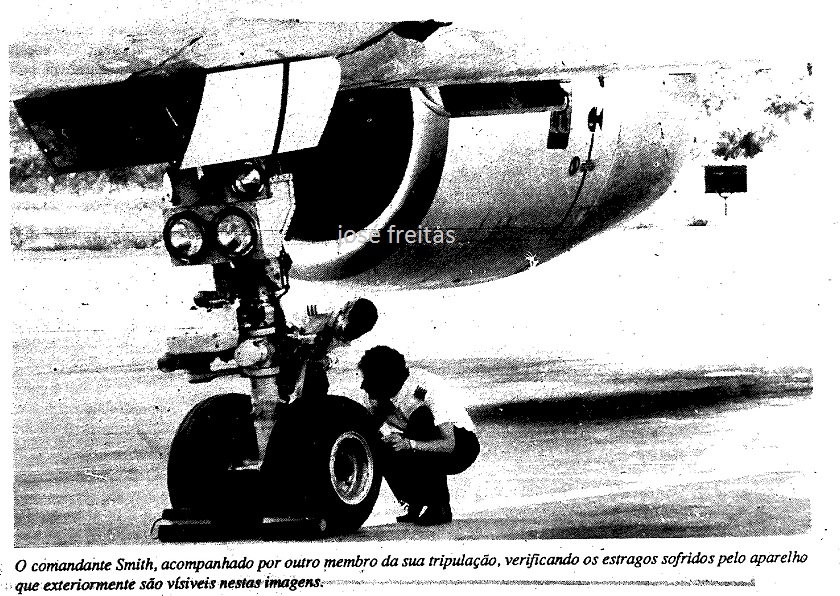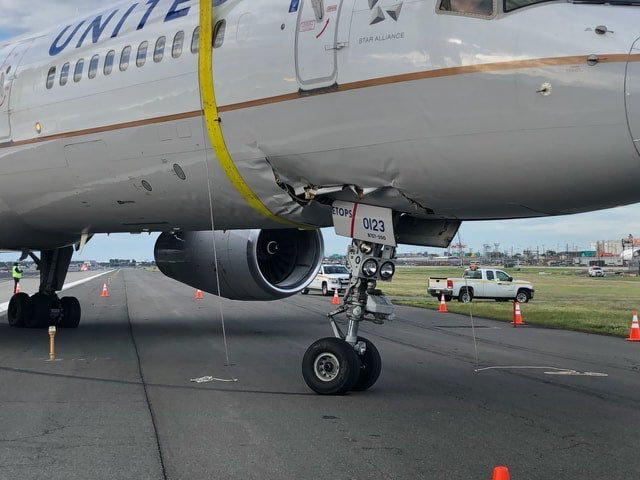UAL 757 incident at EWR
Join Date: Mar 2019
Location: French Alps
Posts: 326
Likes: 0
Received 0 Likes
on
0 Posts
According to meteo reports, the wind was 210/220 13/24 kt, direct headwind.
KEWR 151651Z 21016G24KT 10SM FEW140 SCT180 BKN250 27/09 A3005 RMK AO2 PK WND 20026/1553 SLP177 T02670094
KEWR 151658Z 22013G24KT 10SM FEW130 SCT180 BKN250 27/09 A3005 RMK AO2 T02720089
KEWR 151651Z 21016G24KT 10SM FEW140 SCT180 BKN250 27/09 A3005 RMK AO2 PK WND 20026/1553 SLP177 T02670094
KEWR 151658Z 22013G24KT 10SM FEW130 SCT180 BKN250 27/09 A3005 RMK AO2 T02720089
I seem to remember Air Europe doing something similar at Funchal? I think it was said that the step down into the flight deck was changed to a step up!
It seems that while the 757 is very easy to de-rotate too quickly, giving a hard nose gear landing, it's not built to take those impacts. My recollection is that if you don't fly the nose gear onto the runway before the autobrake bites, you'll run out of elevator authority and can't prevent the nose slamming in?
It seems that while the 757 is very easy to de-rotate too quickly, giving a hard nose gear landing, it's not built to take those impacts. My recollection is that if you don't fly the nose gear onto the runway before the autobrake bites, you'll run out of elevator authority and can't prevent the nose slamming in?
I seem to remember Air Europe doing something similar at Funchal? I think it was said that the step down into the flight deck was changed to a step up!
It seems that while the 757 is very easy to de-rotate too quickly, giving a hard nose gear landing, it's not built to take those impacts. My recollection is that if you don't fly the nose gear onto the runway before the autobrake bites, you'll run out of elevator authority and can't prevent the nose slamming in?
It seems that while the 757 is very easy to de-rotate too quickly, giving a hard nose gear landing, it's not built to take those impacts. My recollection is that if you don't fly the nose gear onto the runway before the autobrake bites, you'll run out of elevator authority and can't prevent the nose slamming in?
Carrying speed well in excess of Vref greatly enhances the chance of a nose wheel first or shallow touchdown and this looks a classic case of that. As someone said perhaps wait for the actual accident report.
Join Date: Mar 2019
Location: French Alps
Posts: 326
Likes: 0
Received 0 Likes
on
0 Posts
Why should people wait for the report in this particular case, while they don't when the accident occurs in another continent with foreing pilots ?
We already do have some facts here : the wind, the state of the airplane.
What we are still to read about, is the usual rigmarole of "should haves", "forgot flying basics", "substandard training", etc.
Join Date: Mar 2001
Location: Left seat of a Boeing... mostly!
Posts: 45
Likes: 0
Received 0 Likes
on
0 Posts
https://en.wikipedia.org/wiki/Britan...ys_Flight_226A Here, nose wheel 'dog box' failed due over load, resulting in a significant runway excursion.
Final report https://www.fomento.es/NR/rdonlyres/..._texto_ENG.pdf
Britannia was generally regarded as having 'high standards' within the industry at the time, a long established operator. However deep night flying (a Britannia Airways 'speciality' since inclusive tour charter flying really got going of the 70s) crew fatigue thought a possible contributing factor in this particular 1999 Boeing 757 accident.
Final report https://www.fomento.es/NR/rdonlyres/..._texto_ENG.pdf
Britannia was generally regarded as having 'high standards' within the industry at the time, a long established operator. However deep night flying (a Britannia Airways 'speciality' since inclusive tour charter flying really got going of the 70s) crew fatigue thought a possible contributing factor in this particular 1999 Boeing 757 accident.
Illyushin.
As as an aside I took a 757 in to Funchal shortly after the Air Europe incident ( our airline stopped 757 operations in to there shortly thereafter). I wandered over to see how the Boeing field engineers ( lots of pens in shirt pockets, crew cuts, and, I suspect, had cut their teeth in ĎNam) , were fixing it. Jacked up the aircraft by using a pit prop through the dv windows. Drifted the nose gear down and welded it down. Then welded the now deformed window back in to the frame and then an AE crew flew it back gear down ( think they retracted the mains not sure ) to Luton. Built like a brick ****house. As all things Boeing were back in the day.
However there are obviously limits. !! 😎😎😎
Last edited by MENELAUS; 16th Jun 2019 at 14:30.
With regards to the post above, the Britannia incident pushed the dog box up just far enough to snag the thrust lever and reverser cables, but not symmetrically. Looks the same here.
I was, uh, rather close to that particular incident.
I was, uh, rather close to that particular incident.
While the design of using the throttle cables to actuate the reverse DCV was common place back then, it has some highly undesirable failure modes. The 757-300/Rolls didn't use that design (I was directly involved in the design change, including having to debate the Chief Engineer who didn't want to make the change).
In the aftermath, Boeing designed a 'guillotine' system - if the nose wheel came back as it did in Britannia, the guillotine was intended to cut the throttle cables in such a way that the engines would go to idle. I think the guillotine was AD'ed but I wouldn't swear to it.
Not quite - there are not 'reverse cables' as such on the 757 - on the 757-200/RB211-535, the throttle cable actuates the reverser Directional Control Valve when it's moved sufficiently aft of forward idle. When the nose gear came back through the EE bay, it snagged the throttle cables in such a way that the engines went to high forward thrust - in that condition it is not possible to deploy the reversers. The combination of high thrust and inability to deploy the reversers made for a rather long overrun.
While the design of using the throttle cables to actuate the reverse DCV was common place back then, it has some highly undesirable failure modes. The 757-300/Rolls didn't use that design (I was directly involved in the design change, including having to debate the Chief Engineer who didn't want to make the change).
In the aftermath, Boeing designed a 'guillotine' system - if the nose wheel came back as it did in Britannia, the guillotine was intended to cut the throttle cables in such a way that the engines would go to idle. I think the guillotine was AD'ed but I wouldn't swear to it.
While the design of using the throttle cables to actuate the reverse DCV was common place back then, it has some highly undesirable failure modes. The 757-300/Rolls didn't use that design (I was directly involved in the design change, including having to debate the Chief Engineer who didn't want to make the change).
In the aftermath, Boeing designed a 'guillotine' system - if the nose wheel came back as it did in Britannia, the guillotine was intended to cut the throttle cables in such a way that the engines would go to idle. I think the guillotine was AD'ed but I wouldn't swear to it.
Join Date: Nov 2015
Location: Paisley, Florida USA
Posts: 289
Likes: 0
Received 0 Likes
on
0 Posts
Join Date: Mar 2006
Location: USA
Posts: 2,515
Likes: 0
Received 0 Likes
on
0 Posts
That was my first thought as well. Hopefully with electronically controlled engines, that failure mode is less of an issue. On to different, newer failures then...
Join Date: Feb 2019
Location: shiny side up
Posts: 431
Likes: 0
Received 0 Likes
on
0 Posts
I dont see many posts on how it happened, just the results of what happened. They landed hard enough to explode all of the rear landing gear tires and push the nose gear up through the fuselage. No conjecture, it is there in the images.
If you pushed the nose gear far enough into the EE bay to activate the guillotine, attempting a go-around would be a pretty bad decision regardless - the flight control cables go through that same area as the throttle cables (not to mention much of the electronics).








